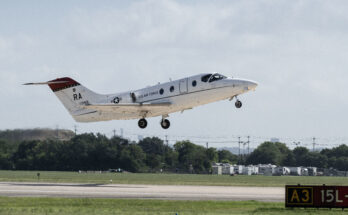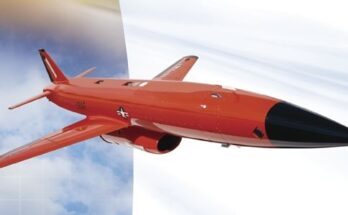
The U.S. military plans to accelerate its fielding of hypersonic weapons despite a series of test issues. On September 6, the Department of Defense postponed a planned test-firing of the U.S. Army’s Dark Eagle Long-Range Hypersonic Weapon System (LRHW). This was the third time that the trial, the second in a series supporting the LRHW and the Navy’s Conventional Prompt Strike (CPS) program, had been canceled. Originally planned for late 2022, preflight issues and a battery problem scrubbed the first two tests.
Under the CPS program, the Army and Navy are developing long-range missiles to deliver the Common Hypersonic Glide Body (C-HGB).
The latest test was intended to evaluate the Army’s weapon-control system and battery operation center for the LRHW. It would also have been the first firing using the Army’s transport erector launcher. Despite the cancellation, defense officials said data were successfully collected on the performance of ground hardware and software that would support the fielding of hypersonic weapons.
Army officials have acknowledged that they will miss the goal of fielding the Dark Eagle LRHW by the end of fiscal 2023 on September 30, but still hope to deliver the capability by the end of the calendar year. Army officials said that the delay was due to the cancellation of an important C-HGB test. That planned test would have been very close to an operational trial rather than a developmental test, the officials said.
The joint CPS program is divided into several phases. The first phase seeks to develop and demonstrate a hypersonic, cold-gas-launched missile system prototype. Plans called for five flight tests under a joint flight campaign. The first (JFC-1) took place in June 2022, but failed after the missile experienced an in-flight anomaly. Following the latest failure, it is not clear when JFC-2 might be rescheduled.
JFC-2 and -3 are intended to support the Army’s LRHW program. The service is required to complete three flight tests before LRHW can move to a program of record. The trials are also necessary for the early fielding of the system with the 5th Battalion, 3rd Field Artillery Regiment, Joint Base Lewis-McChord, Washington, under the Army’s 1st Multidomain Task Force.
The JFC-4 and -5 tests would demonstrate the cold-gas-launch capability for launches from warships. Originally slated for fiscal 2024, these trials will likely be postponed to fiscal 2025, affecting Navy plans to field the CPS on its Zumwalt class destroyers. It could also delay the fielding on Virginia class Block V attack submarines, which is anticipated in 2029.
The Army planned to field the first LRHW battery in fiscal 2023, and additional batteries in fiscal 2025 and fiscal 2027. A battery consists of four transport-erector-launchers, each with two missiles, and a battery operations center. The systems would be assigned to the Strategic Fires Battalion, alongside a High-Mobility Artillery Rocket System (HIMARS) battery and a Mid-Range Capability battery, as part of the 1st Multidomain Task Force.
Since 2018, the U.S. has increased its focus on hypersonic weapons as it revamps its forces for conventional conflict with a peer or near-peer competitor. This shift gained urgency in 2019 when China introduced its first hypersonic weapon, the DF-17, a mobile, medium-range ballistic missile designed to deliver the DF-ZF hypersonic glide vehicle.
The development of any advanced technology is bound to run into challenges. The recent delays should not distract from the significant progress the CPS program has made. It went from a concept in 2019 to delivering hardware two years later. Army officials say that it is better to uncover issues now rather than later after the system has been fielded. Another unsuccessful test, however, may raise deeper questions about the viability of the joint hypersonics program.
This article was originally published on our sister site, Military Periscope, the world’s easiest-to-use, up-to-date, open-source military database covering weapon systems and armed forces from around the world.
Aja Melville is an accomplished editor and analyst with expertise in open-source intelligence (OSINT) and database management. As the Weapons Editor and Analyst at Military Periscope, Aja has applied her analytical skills and in-depth knowledge in military affairs and global defense sector advancements, particularly focusing on China and the Asia-Pacific region.
Aja's commitment to international relations and Asia-Pacific focus is highlighted by her educational background. She holds a Bachelor of Arts in International Relations and Chinese Language from Bard College, complemented by a Certificate of Advanced International Studies from the Bard Globalization and International Affairs Program. Aja further expanded her linguistic skills with a Certificate of Intensive Language Studies in Chinese (Mandarin) from Qingdao University.





